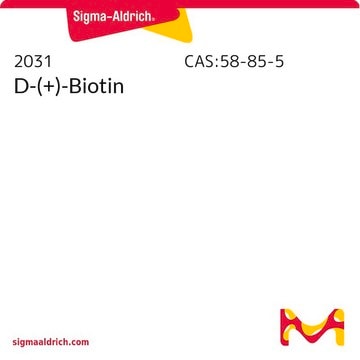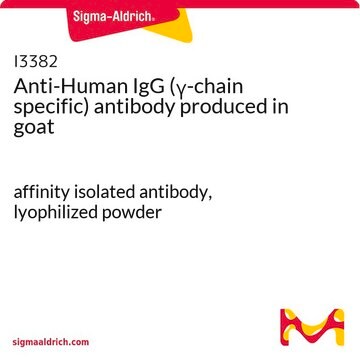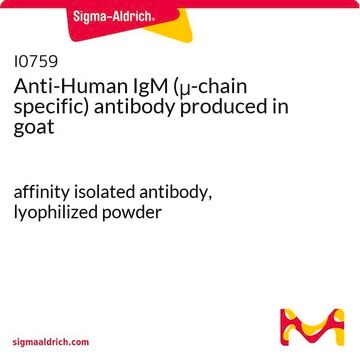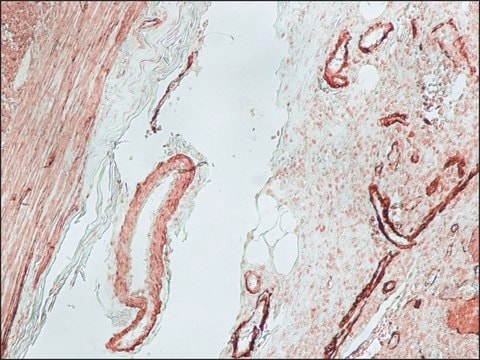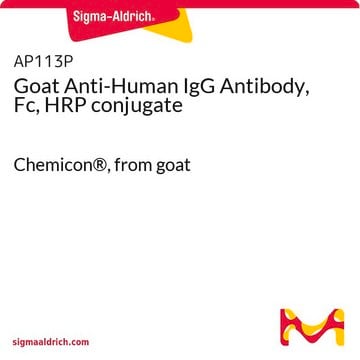B1140
Anti-Human IgG (γ-chain specific)-Biotin antibody produced in goat
affinity isolated antibody, buffered aqueous solution
Sign Into View Organizational & Contract Pricing
All Photos(1)
About This Item
Recommended Products
biological source
goat
Quality Level
conjugate
biotin conjugate
antibody form
affinity isolated antibody
antibody product type
secondary antibodies
clone
polyclonal
form
buffered aqueous solution
technique(s)
direct ELISA: 1:20,000
storage temp.
2-8°C
target post-translational modification
unmodified
General description
Human IgG antibodies are primarily responsible for the facilitation of humoral immune responses such as complement fixation, placental transport, and phagocytosis among many others. Anti-human IgG (γ-chain specific)-biotin antibody can be used in preparation of the double-codified gold nanoparticle label. Goat anti- human IgG (γ-chain specific)-biotin antibody reacts specifically with human IgG but not with other immunoglobulins.
Human IgGs are glycoprotein antibodies that contain two equivalent light chains and a pair of identical heavy chains. IgGs have four distinct isoforms, ranging from IgG1 to IgG4. These antibodies regulate immunological responses to allergy and pathogenic infections. IgGs have also been implicated in complement fixation and autoimmune disorders
Anti-Human IgG (γ-chain specific)-Biotin antibody is specific for human IgG and does not bind other human immunoglobulins.
Anti-Human IgG (γ-chain specific)-Biotin antibody is specific for human IgG and does not bind other human immunoglobulins.
Immunogen
Purified human IgG.
Application
Anti-Human IgG (γ-chain specific)-Biotin antibody is suitable for use in ELISA (1:2000) and double-codified gold nanolabel-based immunoanalysis.
Anti-human IgG (γ-chain specific)-biotin antibody can be used in direct ELISA
Physical form
Solution in 0.01 M phosphate buffered saline, pH 7.4, containing 1% bovine serum albumin and 15 mM sodium azide
Disclaimer
Unless otherwise stated in our catalog or other company documentation accompanying the product(s), our products are intended for research use only and are not to be used for any other purpose, which includes but is not limited to, unauthorized commercial uses, in vitro diagnostic uses, ex vivo or in vivo therapeutic uses or any type of consumption or application to humans or animals.
Not finding the right product?
Try our Product Selector Tool.
Storage Class Code
10 - Combustible liquids
WGK
WGK 3
Flash Point(F)
Not applicable
Flash Point(C)
Not applicable
Certificates of Analysis (COA)
Search for Certificates of Analysis (COA) by entering the products Lot/Batch Number. Lot and Batch Numbers can be found on a product’s label following the words ‘Lot’ or ‘Batch’.
Already Own This Product?
Find documentation for the products that you have recently purchased in the Document Library.
Customers Also Viewed
Eliana Ferreira Monteiro et al.
Pathogens (Basel, Switzerland), 10(9) (2021-09-29)
Plasmodium malariae has a wide geographic distribution, but mainly at very low parasitemias and in co-infections, leading to an underestimated prevalence of this species. Studies for the detection of antibodies against Plasmodium recombinant proteins are increasingly used to map geographical
Alina Sultanova et al.
Microbiology spectrum, 10(3), e0236921-e0236921 (2022-05-24)
Human herpesvirus-6 (HHV-6) contains two genes (U12 and U51) that encode putative homologues of human G-protein-coupled receptors like CCR1, CCR3, and CCR5. It has been shown that these viral proteins can be expressed on the surface of epithelial and some
Adriano Ambrosi et al.
Analytical chemistry, 79(14), 5232-5240 (2007-06-21)
A novel double-codified nanolabel (DC-AuNP) based on gold nanoparticle (AuNP) modified with anti-human IgG peroxidase (HRP)-conjugated antibody is reported. It represents a simple assay that allows enhanced spectrophotometric and electrochemical detection of antigen human IgG as a model protein. The
Robert S Matson et al.
Methods in molecular biology (Clifton, N.J.), 382, 273-286 (2008-01-29)
The ability to perform microarray-based immunoassays without the need for wells or other fluid barriers were demonstrated. Both contact and noncontact microarray printing technology is used to prepare spotted arrays of analyte binding sites, as well as, to deliver samples
Wanwisa Dejnirattisai et al.
Nature immunology, 16(2), 170-177 (2014-12-17)
Dengue is a rapidly emerging, mosquito-borne viral infection, with an estimated 400 million infections occurring annually. To gain insight into dengue immunity, we characterized 145 human monoclonal antibodies (mAbs) and identified a previously unknown epitope, the envelope dimer epitope (EDE)
Our team of scientists has experience in all areas of research including Life Science, Material Science, Chemical Synthesis, Chromatography, Analytical and many others.
Contact Technical Service

